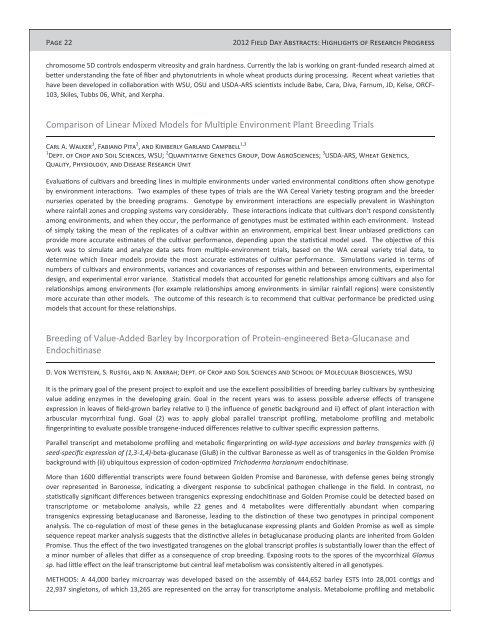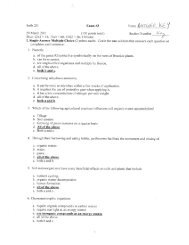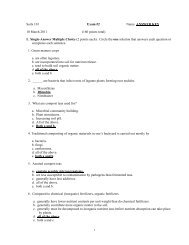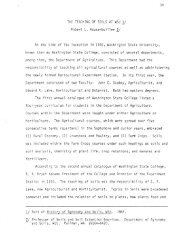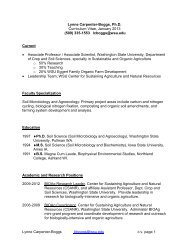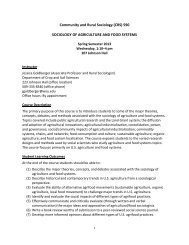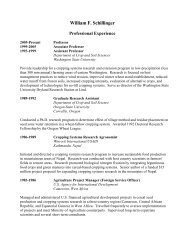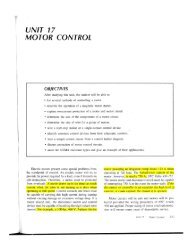2012 Dryland Field Day Abstracts - Dept. of Crop and Soil Sciences ...
2012 Dryland Field Day Abstracts - Dept. of Crop and Soil Sciences ...
2012 Dryland Field Day Abstracts - Dept. of Crop and Soil Sciences ...
Create successful ePaper yourself
Turn your PDF publications into a flip-book with our unique Google optimized e-Paper software.
Page 22<br />
<strong>2012</strong> <strong>Field</strong> <strong>Day</strong> <strong>Abstracts</strong>: Highlights <strong>of</strong> Research Progress<br />
chromosome 5D controls endosperm vitreosity <strong>and</strong> grain hardness. Currently the lab is working on grant-funded research aimed at<br />
better underst<strong>and</strong>ing the fate <strong>of</strong> fiber <strong>and</strong> phytonutrients in whole wheat products during processing. Recent wheat varieties that<br />
have been developed in collaboration with WSU, OSU <strong>and</strong> USDA-ARS scientists include Babe, Cara, Diva, Farnum, JD, Kelse, ORCF-<br />
103, Skiles, Tubbs 06, Whit, <strong>and</strong> Xerpha.<br />
Comparison <strong>of</strong> Linear Mixed Models for Multiple Environment Plant Breeding Trials<br />
Carl A. Walker 1 , Fabiano Pita 2 , <strong>and</strong> Kimberly Garl<strong>and</strong> Campbell 1,3<br />
1 <strong>Dept</strong>. <strong>of</strong> <strong>Crop</strong> <strong>and</strong> <strong>Soil</strong> <strong>Sciences</strong>, WSU; 2 Quantitative Genetics Group, Dow Agro<strong>Sciences</strong>; 3 USDA-ARS, Wheat Genetics,<br />
Quality, Physiology, <strong>and</strong> Disease Research Unit<br />
Evaluations <strong>of</strong> cultivars <strong>and</strong> breeding lines in multiple environments under varied environmental conditions <strong>of</strong>ten show genotype<br />
by environment interactions. Two examples <strong>of</strong> these types <strong>of</strong> trials are the WA Cereal Variety testing program <strong>and</strong> the breeder<br />
nurseries operated by the breeding programs. Genotype by environment interactions are especially prevalent in Washington<br />
where rainfall zones <strong>and</strong> cropping systems vary considerably. These interactions indicate that cultivars don't respond consistently<br />
among environments, <strong>and</strong> when they occur, the performance <strong>of</strong> genotypes must be estimated within each environment. Instead<br />
<strong>of</strong> simply taking the mean <strong>of</strong> the replicates <strong>of</strong> a cultivar within an environment, empirical best linear unbiased predictions can<br />
provide more accurate estimates <strong>of</strong> the cultivar performance, depending upon the statistical model used. The objective <strong>of</strong> this<br />
work was to simulate <strong>and</strong> analyze data sets from multiple-environment trials, based on the WA cereal variety trial data, to<br />
determine which linear models provide the most accurate estimates <strong>of</strong> cultivar performance. Simulations varied in terms <strong>of</strong><br />
numbers <strong>of</strong> cultivars <strong>and</strong> environments, variances <strong>and</strong> covariances <strong>of</strong> responses within <strong>and</strong> between environments, experimental<br />
design, <strong>and</strong> experimental error variance. Statistical models that accounted for genetic relationships among cultivars <strong>and</strong> also for<br />
relationships among environments (for example relationships among environments in similar rainfall regions) were consistently<br />
more accurate than other models. The outcome <strong>of</strong> this research is to recommend that cultivar performance be predicted using<br />
models that account for these relationships.<br />
Breeding <strong>of</strong> Value-Added Barley by Incorporation <strong>of</strong> Protein-engineered Beta-Glucanase <strong>and</strong><br />
Endochitinase<br />
D. Von Wettstein, S. Rustgi, <strong>and</strong> N. Ankrah; <strong>Dept</strong>. <strong>of</strong> <strong>Crop</strong> <strong>and</strong> <strong>Soil</strong> <strong>Sciences</strong> <strong>and</strong> School <strong>of</strong> Molecular Biosciences, WSU<br />
It is the primary goal <strong>of</strong> the present project to exploit <strong>and</strong> use the excellent possibilities <strong>of</strong> breeding barley cultivars by synthesizing<br />
value adding enzymes in the developing grain. Goal in the recent years was to assess possible adverse effects <strong>of</strong> transgene<br />
expression in leaves <strong>of</strong> field-grown barley relative to i) the influence <strong>of</strong> genetic background <strong>and</strong> ii) effect <strong>of</strong> plant interaction with<br />
arbuscular mycorrhizal fungi. Goal (2) was to apply global parallel transcript pr<strong>of</strong>iling, metabolome pr<strong>of</strong>iling <strong>and</strong> metabolic<br />
fingerprinting to evaluate possible transgene-induced differences relative to cultivar specific expression patterns.<br />
Parallel transcript <strong>and</strong> metabolome pr<strong>of</strong>iling <strong>and</strong> metabolic fingerprinting on wild-type accessions <strong>and</strong> barley transgenics with (i)<br />
seed-specific expression <strong>of</strong> (1,3-1,4)-beta-glucanase (GluB) in the cultivar Baronesse as well as <strong>of</strong> transgenics in the Golden Promise<br />
background with (ii) ubiquitous expression <strong>of</strong> codon-optimized Trichoderma harzianum endochitinase.<br />
More than 1600 differential transcripts were found between Golden Promise <strong>and</strong> Baronesse, with defense genes being strongly<br />
over represented in Baronesse, indicating a divergent response to subclinical pathogen challenge in the field. In contrast, no<br />
statistically significant differences between transgenics expressing endochitinase <strong>and</strong> Golden Promise could be detected based on<br />
transcriptome or metabolome analysis, while 22 genes <strong>and</strong> 4 metabolites were differentially abundant when comparing<br />
transgenics expressing betaglucanase <strong>and</strong> Baronesse, leading to the distinction <strong>of</strong> these two genotypes in principal component<br />
analysis. The co-regulation <strong>of</strong> most <strong>of</strong> these genes in the betaglucanase expressing plants <strong>and</strong> Golden Promise as well as simple<br />
sequence repeat marker analysis suggests that the distinctive alleles in betaglucanase producing plants are inherited from Golden<br />
Promise. Thus the effect <strong>of</strong> the two investigated transgenes on the global transcript pr<strong>of</strong>iles is substantially lower than the effect <strong>of</strong><br />
a minor number <strong>of</strong> alleles that differ as a consequence <strong>of</strong> crop breeding. Exposing roots to the spores <strong>of</strong> the mycorrhizal Glomus<br />
sp. had little effect on the leaf transcriptome but central leaf metabolism was consistently altered in all genotypes.<br />
METHODS: A 44,000 barley microarray was developed based on the assembly <strong>of</strong> 444,652 barley ESTS into 28,001 contigs <strong>and</strong><br />
22,937 singletons, <strong>of</strong> which 13,265 are represented on the array for transcriptome analysis. Metabolome pr<strong>of</strong>iling <strong>and</strong> metabolic


